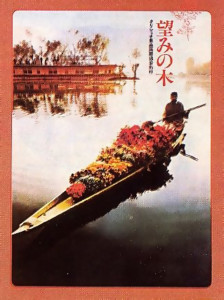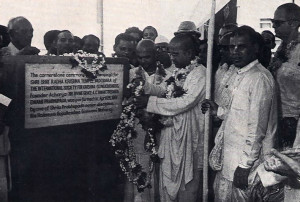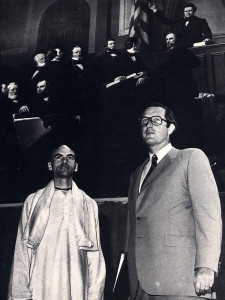A look at the worldwide activities of the
International Society for Krishna Consciousness (ISKCON)
Hare Krishna—You Can Look It Up
 Hare Krishna is now a dictionary word. While browsing through the most recent edition of The Random House Dictionary of the English Language, we were pleased to find this entry: “Hare Krishna. A religious sect based on Vedic scriptures, whose followers engage in joyful congregational chanting of God’s name: founded in the U.S. in 1966. [from part of the chant]”
Hare Krishna is now a dictionary word. While browsing through the most recent edition of The Random House Dictionary of the English Language, we were pleased to find this entry: “Hare Krishna. A religious sect based on Vedic scriptures, whose followers engage in joyful congregational chanting of God’s name: founded in the U.S. in 1966. [from part of the chant]”
Of course. Hare Krishna was part of the Sanskrit lexicon before English even existed. But in the short time since His Divine Grace A.C. Bhaktivedanta Swami Prabhupada brought Hare Krishna to the West, these ancient Sanskrit words have become an accepted part of the modern English language.
“Desire Tree” Offers Japanese the Fruit of Vedic Knowledge
Tokyo—The Japanese branch of the Bhaktivedanta Book Trust has just published the first full-color Krsna-conscious magazine in Japanese. Called Nozomi no ki (Desire Tree), the twenty-four-page magazine contains articles on Buddhism (and its roots in Vedic culture), reincarnation, and chanting Hare Krsna .
100,000 in Gujarat Inaugurate Cultural Project

Baroda, India—The Hare Krsna movement has begun constructing a new cultural center in the heart of Baroda, an elegant old city in Gujarat (a state on India’s west coast that is home for more than five million devotees of Lord Krsna). The center, situated on five acres of land, will include a Radha-Krsna temple surrounded by a tropical garden, a theater, a restaurant, a guesthouse, an asrama, and a guru-kula school for primary education. More than 100,000 guests attended the three-day festival to dedicate the project, which the movement plans to complete by 1985.
Vedic Culture Now Taught in German University Town
Heidelberg, West Germany—Nestled in the green valleys along the River Neckar, the town of Heidelberg, famous as a center of education since medieval times, has now added a new feature to its long cultural tradition: The Center for Vedic Studies.
Just a fifteen-minute walk from the university, the Center is the Hare Krsna movement’s way of presenting the ancient philosophical, cultural, and religious experience of India to Heidelberg’s residents and visitors who have an educated interest—or just simple curiosity.
The Center sponsors films, slide presentations, art exhibits, lectures on Vedic philosophy, and a daily program of lunch, devotional music, and brief talks about the Vedic experience. The Center also includes a shopping annex, offering Indian clothes, handicrafts, and devotional items, and it houses the publishing offices for the German-language counterpart of back to godhead.
Hare Krsna In the Holy Land
Haifa, Israel—The Hare Krsna movement now has a rural asrama near this Israeli port and industrial center. The ten-acre community, called Neve Hemed, “the Oasis of Sweetness,” lies in Israel’s most fertile valley, the Emeq Yisrael, and is surrounded by many kibbutzim (communal farms).
Rockefeller Praises Work of Krsna Devotee

Wheeling, West Virginia—Jay Rockefeller, Governor of West Virginia, recently came to the Wheeling Civic Center to dedicate two historical murals, one of them painted by Muralidhara dasa, a devotee of Krsna. Appreciating Muralidhara’s work, which the Governor praised as “beautiful” and “extraordinary,” the Wheeling newspaper said that the Ohio Valley (of which Wheeling is a part) is “fortunate to have an individual of his caliber.” Muralidhara is the artistic director for Prabhupada’s Palace of Gold, the Hare Krsna movement’s memorial to His Divine Grace A.C. Bhaktivedanta Swami Prabhupada at the nearby New Vrindaban Community. Muralidhara donated for the Palace the $5,000 fee he received for the mural.
150,000 Celebrate “Festival of the Chariots”
Bombay—The Hare Krsna movement recently sponsored Bombay’s first Jagannatha Ratha-yatra, “The Festival of the Chariots.” Some 150,000 people took part in the eight-mile procession from Shivaji Park to Chowpatty Beach, where the movement held a week-long festival of Hare Krsna chanting, devotional dramas, lectures on Krsna conscious philosophy, and feasting on food offered to Lord Jagannatha—Krsna, Lord of the Universe.
Krsna Philosophy “En Espanol”
Los Angeles—The Spanish Division of the Bhaktivedanta Book Trust has now shipped more than fourteen million Spanish books of Krsna conscious philosophy and culture to sixteen countries, including Spain, Mexico, and the United States. Last year alone, the division printed more than 2,700,000 books. Among the books in print are illustrated hardbound editions of Bhagavad-gita As It Is and the multi-volume Srimad-Bhagavatam, as well as numerous paperbacks.
Indian Associations Award Drama Prize To Hare Krsna Troupe
New York City—A drama troupe from the Hare Krsna movement recently won first prize at an Indian drama festival held at the Columbia University School of International Affairs. The troupe, the Brijbasi Players, came from the movement’s New Vrindaban community in West Virginia. They performed a dramatization from the Srimad-Bhagavatam, an ancient Indian classic that is one of the movement’s principal scriptures. The festival was sponsored by the Federation of Indian Associations.

Leave a Reply